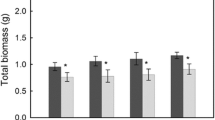Abstract
Biochar, or pyrolyzed organic matter intended for use as a soil amendment, has a variety of properties of interest from the perspective of agroforestry, in particular its potential to increase soil C sequestration and enhance yields by increased retention of soil mineral nutrients. Nitrogen-fixing legumes commonly show large growth responses to biochar, and we hypothesized that combinations of legumes and non-legumes would show increased enhancement of yields in mixture due to enhanced facilitation related to increased nutrient retention. This hypothesis was tested in a glasshouse pot trial involving the leguminous tree leucaena (Leucaena leucocephala), and maize (Zea mays) grown for 120 days in mixture and monoculture in both an unamended soil and soil amended with a slow-pyrolysis coconut husk biochar at 10 t/ha. Responses were quantified in terms of biomass production and partitioning, leaf-level gas-exchange, leaf chlorophyll content, and (for leucaena) root nodule formation. Consistent with predictions, leucaena showed more pronounced growth and physiological responses to biochar than did maize. The system also showed increased total biomass yields relative to monocultures in the two-species mixtures with biochar (relative yield in mixture [RYM] = 1.69; 95% CI 1.41–1.81), but not in the control treatment (RYM = 1.25; 95% CI 0.93–1.76), and positive effects of biochar on yield were generally greater for both species when grown in mixture. Growth responses to biochar were most pronounced for stem and root biomass, and growth responses were consistent with changes in leaf-level photosynthesis and chlorophyll content. In addition, biochar had large effects on biomass partitioning, enhancing stem allocation in both species. Our results suggest that biochar additions may augment facilitative interactions in agroforestry and intercropped systems on acidic, nutrient-deficient soils by enhancing system nutrient retention.






Similar content being viewed by others
References
Angst TE, Sohi SP (2013) Establishing release dynamics for plant nutrients from biochar. GCB Bioenergy 5:221–226
Basso AS, Miguez FE, Laird DA, Horton R, Westgate M (2013) Assessing potential of biochar for increasing water-holding capacity of sandy soils. GCB Bioenergy 5:132–143
Biederman LA, Harpole WS (2013) Biochar and its effects on plant productivity and nutrient cycling: a meta-analysis. GCB Bioenergy 5:202–214
Bilalis DJ, Sidiras N, Kakampouki I, Efthimiadou A, Papatheohari Y, Thomopoulos P (2005) Effects of organic fertilization on maize/legume intercrop in a clay loam soil and Mediterranean climate—can the Land Equivalent Ratio (LER) index be used for root development? J Food Agric Environ 3:117–123
Chang JF, Shibles RM (1985) An analysis of competition between intercropped cowpea and maize I. Soil N and P levels and their relationships with dry matter and seed productivity. Field Crops Res 12:133–143
Crane-Droesch A, Abiven S, Jeffery S, Torn MS (2013) Heterogeneous global crop yield response to biochar: a meta-regression analysis. Environ Res Let 8:044049
DeLuca TH, Gundale MJ, MacKenzie MD, Jones DL (2015) Biochar effects on soil nutrient transformations. In: Lehmann J, Joseph S (eds) Biochar for environmental management: science, technology and implementation, 2nd edn. Routledge, London, pp 421–454
Deng B, Tammeorg P, Luukkanen O, Helenius J, Starr M (2017) Effects of Acacia seyal and biochar on soil properties and sorghum yield in agroforestry systems in South Sudan. Agrofor Syst 91:137–148
Fulton W, Gray M, Prahl F, Kleber M (2013) A simple technique to eliminate ethylene emissions from biochar amendment in agriculture. Agron Sustain Dev 33:469–474
Gale NV, Sackett TE, Thomas SC (2016) Thermal treatment and leaching of biochar alleviates plant growth inhibition from mobile organic compounds. PeerJ 4:e2385
Gibson D, Connolly J, Hartnett D, Weidenhamer J (1999) Designs for greenhouse studies of interactions between plants. J Ecol 87:1–16
Glaser B, Lehmann J, Zech W (2002) Ameliorating physical and chemical properties of highly weathered soils in the tropics with charcoal—a review. Biol Fert Soils 35:219–230
Jeffery S, Abalos D, Prodana M, Bastos AC, van Groenigen JW, Hungate BA, Verheijen F (2017) Biochar boosts tropical but not temperate crop yields. Environ Res Let 12:053001
Jose S (2009) Agroforestry for ecosystem services and environmental benefits: an overview. Agrofor Syst 76:1–10
Kim DG, Kirschbaum MU, Beedy TL (2016) Carbon sequestration and net emissions of CH4 and N2O under agroforestry: synthesizing available data and suggestions for future studies. Agric Ecosys Environ 226:65–78
Krapfl KJ, Hatten JA, Roberts SD, Baldwin BS, Rousseau RJ, Shankle MW (2016) Capacity of biochar application and nitrogen fertilization to mitigate grass competition upon tree seedlings during stand regeneration. For Ecol Manag 376:298–309
Kuttner BG, Thomas SC (2017) Interactive effects of biochar and an organic dust the ressant for revegetation and erosion control with herbaceous seed mixtures and willow cuttings. Restor Ecol 25:367–375
Laird D, Rogovska N (2015) Biochar effects on nutrient leaching. In: Lehmann J, Joseph S (eds) Biochar for environmental management. Routledge, London, pp 553–574
Lehmann J, Joseph S (eds) (2015) Biochar for environmental management: science, technology and implementation, 2nd edn. Routledge, London
Li L, Yang S, Li X, Zhang F, Christie P (1999) Interspecific complementary and competitive interactions between intercropped maize and faba bean. Plant Soil 212:105–114
Li QZ, Sun JH, Wei XJ, Christie P, Zhang FS, Li L (2011) Overyielding and interspecific interactions mediated by nitrogen fertilization in strip intercropping of maize with faba bean, wheat and barley. Plant Soil 339:147–161
Liu X, Zhang A, Ji C, Joseph S, Bian R, Li L, Pan G, Paz-Ferreiro J (2013) Biochar's effect on crop productivity and the dependence on experimental conditions—a meta-analysis of literature data. Plant Soil 373:583–594
Lorenz K, Lal R (2014) Soil organic carbon sequestration in agroforestry systems: a review. Agron Sustain Dev 34:443–454
Macdonald LM, Farrell M, Van Zwieten L, Krull ES (2014) Plant growth responses to biochar addition: an Australian soils perspective. Biol Fert Soils 50:1035–1045
Major J, Rondon M, Molina D, Riha SJ, Lehmann J (2010) Maize yield and nutrition during 4 years after biochar application to a Colombian savanna oxisol. Plant Soil 333:117–128
Mete FA, Mia S, Dijkstra FA, Abuyusuf M, Hossain ASMI (2015) Synergistic effects of biochar and NPK fertilizer on soybean yield in an alkaline soil. Pedosphere 25:713–719
Mia S, Van Groenigen JW, Van de Voorde TFJ, Oram NJ, Bezemer TM, Mommer L, Jeffery S (2014) Biochar application rate affects biological nitrogen fixation in red clover conditional on potassium availability. Ag Ecosystems Environ 191:83–91
Miltner BC, Coomes OT (2015) Indigenous innovation incorporates biochar into swidden-fallow agroforestry systems in Amazonian Peru. Agrofor Syst 89:409–420
Nair PKR, Kumar BM, Nair VD (2009) Agroforestry as a strategy for carbon sequestration. J Plant Nut Soil Sci 172:10–23
Ndakidemi PA, Dakora FD (2007) Yield components of nodulated cowpea (Vigna unguiculata) and maize (Zea mays) plants grown with exogenous phosphorus in different cropping systems. Austral J Exp Ag 47:583–589
Ogawa M, Okimori Y (2010) Pioneering works in biochar research, Japan. Aust J Soil Res 48:489–500
Oram NJ, van de Voorde TF, Ouwehand GJ, Bezemer TM, Mommer L, Jeffery S, Van Groenigen JW (2014) Soil amendment with biochar increases the competitive ability of legumes via increased potassium availability. Agric Ecosyst Environ 191:92–98
Palm CA (1995) Contribution of agroforestry trees to nutrient requirements of intercropped plants. Agrofor Syst 30:105–124
Parvage MM, Ulén B, Eriksson J, Strock J, Kirchmann H (2013) Phosphorus availability in soils amended with wheat residue char. Biol Fert Soils 49:245–250
Qian L, Chen B, Hu D (2013) Effective alleviation of aluminum phytotoxicity by manure-derived biochar. Environ Sci Technol 47:2737–2745
Quilliam RS, DeLuca TH, Jones DL (2013) Biochar application reduces nodulation but increases nitrogenase activity in clover. Plant Soil 366:83–92
R Core Team (2016) R: a language and environment for statistical computing. R Foundation for Statistical Computing, Vienna
Rizvi SJH, Tahir M, Rizvi V, Kohli RK, Ansari A (1999) Allelopathic interactions in agroforestry systems. Crit Rev Plant Sci 18:773–796
Rondon M, Lehmann J, Ramírez J, Hurtado M (2007) Biological nitrogen fixation by common beans (Phaseolus vulgaris L.) increases with bio-char additions. Biol Fert Soils 43:699–708
Sackett TE, Basiliko N, Noyce GL, Winsborough C, Schurman J, Ikeda C, Thomas SC (2015) Soil and greenhouse gas responses to biochar additions in a temperate hardwood forest. GCB Bioenergy 7:1062–1074
Sileshi GW, Akinnifesi FK, Ajayi OC, Muys B (2011) Integration of legume trees in maize-based cropping systems improves rain use efficiency and yield stability under rain-fed agriculture. Agric Water Manag 98:1364–1372
Snaydon RW (1991) Replacement or additive designs for competition studies? J Appl Ecol 28:930–946
Spokas KA, Baker JM, Reicosky DC (2010) Ethylene: potential key for biochar amendment impacts. Plant Soil 333:443–452
Stavi I (2013) Biochar use in forestry and tree-based agro-ecosystems for increasing climate change mitigation and adaptation. Int J Sust Dev World 20:166–181
Stavi I, Lal R (2013) Agroforestry and biochar to offset climate change: a review. Agron Sustain Dev 33:81–96
Sujeeun L, Thomas SC (2017) Potential of biochar to mitigate allelopathic effects in tropical island invasive plants: evidence from seed germination trials. Trop Conserv Sci 10:1–14
Tagoe SO, Takatsugu Horiuchi T, Matsui T (2008) Effects of carbonized and dried chicken manures on the growth, yield, and N content of soybean. Plant Soil 306:211–220
Thomas SC, Gale N (2015) Biochar and forest restoration: a review and meta-analysis of tree growth responses. New For 46:931–946
Trenbath BR (1974) Biomass productivity of mixtures. Adv Agron 26:177–210
Tsay JS, Fukai S, Wilson GL (1989) Growth and yield of cassava as influenced by intercropped soybean and by nitrogen application. Field Crops Res 21:83–94
Turner ER (1955) The effect of certain adsorbents on the nodulation of clover plants. Ann Bot 19:149–160
Van de Voorde TF, Bezemer TM, Van Groenigen JW, Jeffery S, Mommer L (2014) Soil biochar amendment in a nature restoration area: effects on plant productivity and community composition. Ecol Appl 24:1167–1177
Vandermeer JH (1992) The ecology of intercropping. Cambridge University Press, Cambridge
Vantsis JT, Bond G (1950) The effect of charcoal on the growth of leguminous plants in sand culture. Ann Appl Biol 37:159–168
Wilson JB (1988) Shoot competition and root competition. J Appl Ecol 25:279–296
Yobterik AC, Timmer VR, Gordon AM (1994) Screening agroforestry tree mulches for corn growth: a combined soil test, pot trial and plant analysis approach. Agrofor Syst 25:153–166
Acknowledgements
We thank Rivka Zelikson, Anna Almero, and Rajit Patankar for assistance with the experiment, and Adam Martin for helpful comments on the manuscript. Haliburton Forest and Wild Life Reserve, Ltd., is thanked for providing growth media. This work was funded by grants from the Canadian National Science and Engineering Research Council.
Author information
Authors and Affiliations
Corresponding author
Electronic supplementary material
Below is the link to the electronic supplementary material.
Rights and permissions
About this article
Cite this article
Thomas, S.C., Halim, M.A., Gale, N.V. et al. Biochar enhancement of facilitation effects in agroforestry: early growth and physiological responses in a maize-leucaena model system. Agroforest Syst 93, 2213–2225 (2019). https://doi.org/10.1007/s10457-018-0336-1
Received:
Accepted:
Published:
Issue Date:
DOI: https://doi.org/10.1007/s10457-018-0336-1




